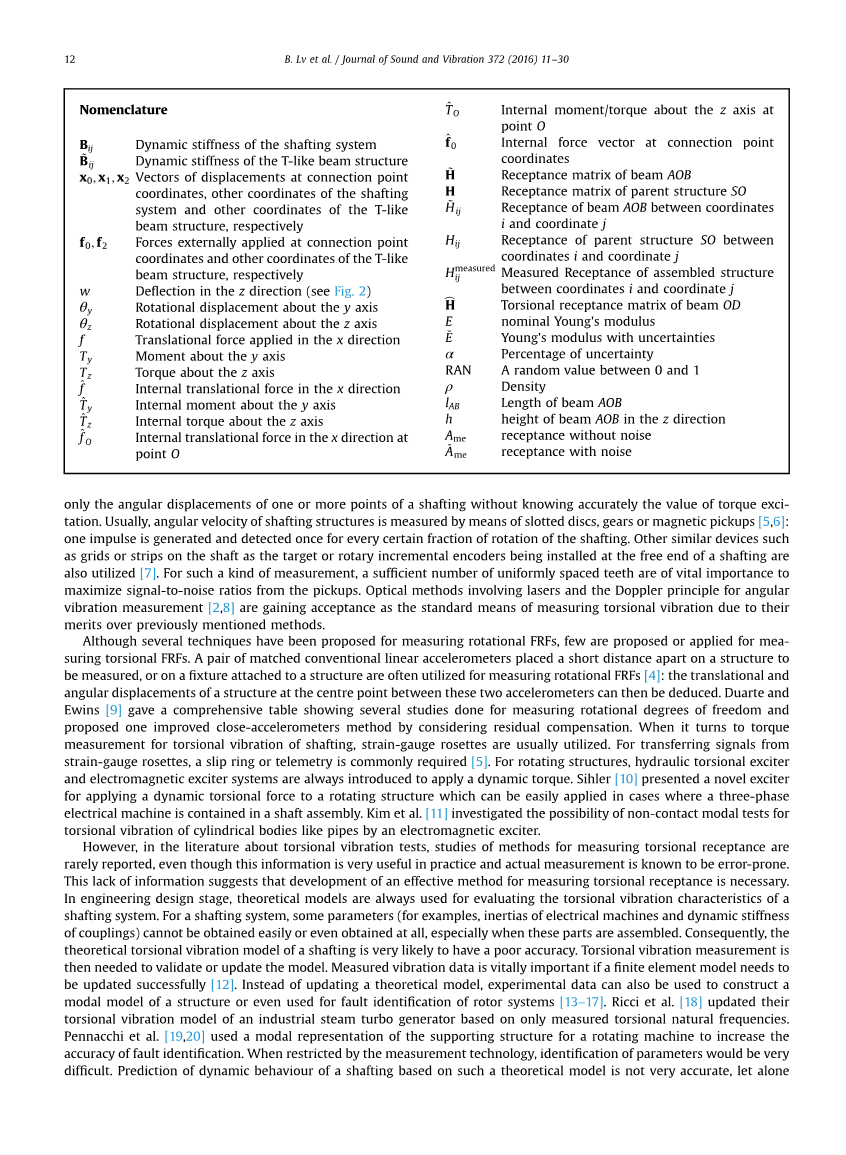

英语原文共 20 页,剩余内容已隐藏,支付完成后下载完整资料
An indirect torsional vibration receptance measurement method for shaft structures
一种间接测量轴结构扭转振动柔度的方法
ABSTRACT
摘要
In this paper. An indirect method for measuring torsional vibration of shaft structures is established. In conventional torsional vibration measurement,knowledge of two fundamental quantities is needed: a torque applied to the system and the angle of twist thus produced, which are both difficult to measure in experiment. In this indirect method, neither a deliberate torque excitation system nor an angular transducer is needed. Instead, a T-like beam structure is introduced and attached to one end of a shaft structure whereby the torques are produced by ordinary forces and only linear accelerometers at a few locations of the beam structure are used. Through the small finite element model of the T-like beam structure, the torsional receptance linking the torque to the angle of twist of the shafting systems is derived from the measured receptances of linear acceleration to the excitation force. This indirect theoretical-experimental combined method overcomes the difficulties and the associated poor accuracy in measuring receptances of torsional vibration of shaft structures, and hence is very useful. Numerical simulation of a test structure with noisy parameters and noisy simulated receptance data is made to validate the theoretical soundness of the method. Vibration tests are carried out on a laboratory shaft structure to demonstrate its accuracy and ease of use.
copy;2016 Elsevier Ltd. All rights reserved.
译:本文建立了一种间接测量轴结构扭转振动的方法。在传统的扭转振动测量中,有两个基本量的知识是需要的,即应用于系统的扭矩和因扭转而产生的扭转角。这两种量在试验中测量都是非常困难的。在间接的测量方法中,既不需要特定的扭矩激励系统,也不需要角度传感器。取而代之的是一个T型梁结构。将引入的T型梁结构与轴结构的一端相连,则梁的扭矩是由普通力产生的,并且仅仅会在梁结构的少许位置上使用线加速度计。线加速度计测量的柔度与激振力衍生出扭转柔度,扭转柔度通过微小的T型梁有限元模型把轴系统的转矩和扭转角连系在一起。这种间接的理论实验结合法克服了测量轴结构扭转振动柔度困难和相关精度差(的问题),因此非常有用。用噪声参数和噪声模拟柔度数据来测试结构并进行数值模拟,以验证这种方法的理论的可行性。振动测试在实验室的轴结构上进行,来证明它的精确性和易用性。
copy;2016 Elsevier有限公司。版权所有。
- Introduction
Shafts are common mechanical components that transmit mechanical power and withstand torques. In most cases, the torque a shaft bears would have a fluctuating component. When the frequency of this fluctuation is close to any torsional natural frequencies of the shaft, even a small torque can excite torsional resonance of the shaft and considerable damage may be caused to a machine such as fatigue failure, rapid bearing wear, gear hammering, fan belt slippage and often excessive noise problems[1-3]. Although many researchers have tried to measure frequency response function (FRF) data for rotational degrees-of -freedom (DOFs), only limited success has been made[4] and the accuracy of FRF of torsional vibration data is well known to be poor.
- 简介
轴是一种常见的能传递机械能和承受扭矩的机械部件。在大多数情况下,轴承的扭矩会有波动的成分。当波动的频率接近轴的任何固有频率,甚至很小的扭矩都能激发轴的扭转共振并且会对机器造成相当大的损害,例如疲劳失效,高速轴承磨损,齿轮锤击,轴承滑移和经常过多噪声的问题[1-3]。尽管有许多研究者曾经尝试过测量扭转自由度的频率响应函数,但是只获得了有限成度的成功[4],并且众所周知的是所测得的扭转振动数据的频率响应函数精度也很差。
The problem of measuring torsional vibration can be tackled from two acceleration response measurement and torque excitation. Several techniques have been developed for torsional vibration tests based on measuring only the angular displacements of one or more points of a shafting without knowing accurately the value of torque excitation. Usually, angular velocity of shafting structures is measured by means of slotted discs, gears or magnetic pickups [5,6]: one impulse is generated and detected once for every certain fraction of rotation of the shafting. Other similar devices such as grids or trips on the shaft as the target or rotary incremental encoders being installed at the free end of a shafting are also utilized [7]. For such a kind of measurement, a sufficient number of uniformly spaced teeth are of vital importance to maximize signal-to-noise ratios from the pickups. Optical methods involving lasers and the Doppler principle for angular vibration measurement [2,8] are gaining acceptance as the standard means of measuring torsional vibration due to their merits over previously mentioned methods.
测量扭转振动的问题可以通过测量两个加速度响应和扭矩激励来解决。扭转振动测试的几个技术是在不知道轴系扭矩激励的准确值的情况下,以测量轴系一个点或多个点的角位移为基础发展起来的。通常情况下,轴系材料的角速度是通过槽盘,齿轮或磁性拾振器来测量的[5,6],轴系每旋转一部分就会测量一次并产生一个脉冲。其他相似的装置例如把轴上的格子或行程作为目标,安装在轴系自由端的旋转增量编码器也会被使用[7]。对于这一种测量方法,足够数量均匀分布的齿对于最大限量的提高拾振器的信噪比是至关重要的。光学法测量扭转角涉及到激光器和多普勒原理[2,8]。因为之前所预先提到的优点这种方法作为测量扭转振动标准方法而获得认可。
Although several techniques have been proposed for measuring rotational FRFs, few are proposed or applied for measuring torsional FRFs. A pair of matched conventional linear accelerometers placed a short distance apart on a structure to be measured, or on a fixture attached to a structure are often utilized for measuring rotational FRFs[4]:the translational and angular displacements of a structure at the centre point between these two accelerometers can then be deduced. Duarte and Ewins [9] gave a comprehensive table showing several studies done for measuring rotational degrees of freedom and proposed one improved close-accelerometers method by considering residual compensation. When it turns to torque measurement for torsional vibration of shafting, strain-gauge rosettes are usually utilized. For transferring signals from strain-gauge rosettes, a slip ring or telemetry is commonly required [5]. For rotating structures, hydraulic torsional exciter and electromagnetic exciter system are always introduced to apply a dynamic torque. Sihler [10] presented a novel exciter for applying a dynamic torsional force to a rotating structure which can be easily applied in cases where a three-phase electrical machine is contained in a shaft assembly. Kim e
全文共28508字,剩余内容已隐藏,支付完成后下载完整资料
资料编号:[145196],资料为PDF文档或Word文档,PDF文档可免费转换为Word


